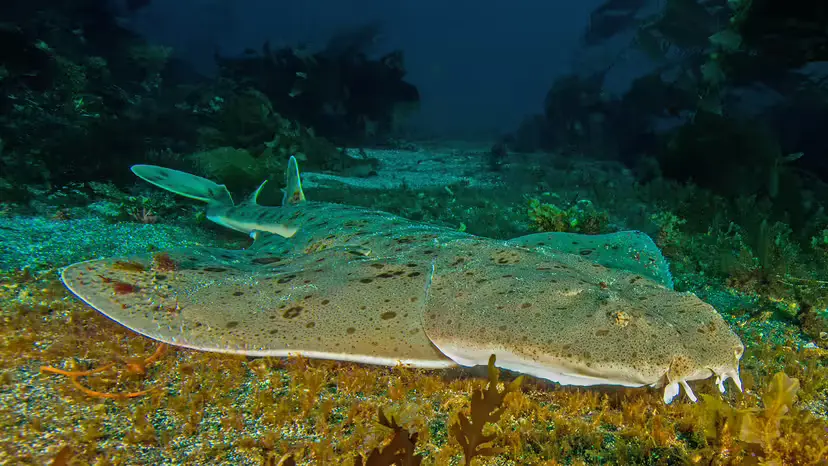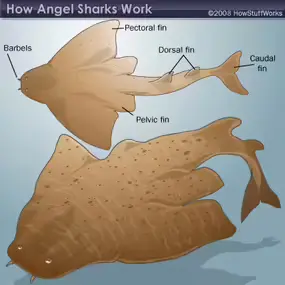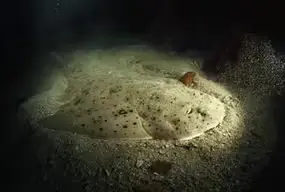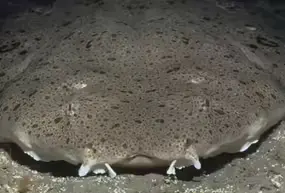Genus/Family: Squatina / Squatinidae (angel sharks)
Common names: Angel shark, Sand devil
Typical size: ~1.5 m (about 5 ft); some species to ~2 m (6.5 ft)
Build: Broad, flattened body; very wide pectoral fins; lower tail lobe longer than upper
Lifestyle: Benthic (seafloor) ambush predator, expert at camouflage
Main threats: Bycatch in bottom fisheries; habitat loss and degradation
Conservation: Many species listed as Endangered or Critically Endangered

Angel sharks look ray-like at a glance, but anatomy tells a different story:
Pectoral fins: Broad and “wing-like,” yet not fused to the head (in rays they are).
Gill slits: On the sides of the head (rays’ are on the underside).
Skeleton/teeth: Classic shark features with triangular, needle-tipped teeth tailored for gripping prey.
The name “angel” comes from those wing-like fins forming a haloed outline; “sand devil” nods to their fierce, sudden strike from concealment.
Flattened profile: Dorsoventrally compressed body lets them lie flush with sand or mud.
Barbels: Whisker-like sensory organs near the mouth help detect chemical and tactile cues on the bottom.
Spiracles: Openings behind the eyes that draw water over the gills while the mouth is buried—so they can breathe without swimming.
Tail (caudal fin): Unusual for sharks—the lower lobe is longer, aiding a rapid upward lunge from the seabed.
Camouflage: Greys, browns, blacks, creams, and speckles/rosettes match local substrates; individuals often half-bury in sand with only eyes exposed.

Angel sharks occur patchily across the Atlantic and Pacific (with limited presence on the SW rim of the Indian Ocean). They occupy shallow shelves to ~1,300 m (4,265 ft), especially sand/mud plains, seagrass edges, and rubble around reefs.
They’re typically sedentary ambushers: staying at favored “hotspots” for days, then shifting when prey become wary. Many are crepuscular/nocturnal, but patterns vary by species and locality.
Set the trap: Settle into sand/mud, eyes up, barbels sampling the flow.
Trigger: Prey (flatfish, other bony fishes, crustaceans, cephalopods/mollusks) enters the strike zone.
Explosive attack: The front body hinges upward and the jaws snap shut—an ambush measured in tenths of a second.
Low energy outlay + lightning strikes = a classic sit-and-wait predator.
Mode: Ovoviviparous—eggs develop inside the female; pups are born live.
Gestation: Roughly 8–10 months (varies by species).
Litter size: About 6–25 pups; neonates ~23 cm (9 in).
Strategy: Slow growth, late maturity, and low reproductive output (K-selected traits) make populations slow to recover after fishing pressure.

There are ~24 recognized species of Squatina, with regional endemics:
Northeast Pacific: S. californica (Pacific angel shark)
NW Pacific: S. japonica (Japanese angel shark), S. nebulosa
East Atlantic/Mediterranean: S. squatina (common angel shark), S. aculeata, S. oculata
Australia region: S. australis, S. albipunctata, S. tergocellata
Americas (Atlantic/SE Pacific): S. argentina, S. armata, S. varii, S. guggenheim, S. occulta
Taxonomy and range boundaries continue to refine as surveys and genetics improve.
Many angel sharks are Endangered or Critically Endangered. Key pressures include:
Bycatch: Bottom gillnets and trawls readily ensnare flat-bodied, seafloor-dwelling sharks.
Habitat loss: Coastal development, pollution, and seafloor disturbance (including trawling impacts) degrade critical habitats.
Biology: Slow life histories reduce resilience to overfishing.
Priority actions
Seasonal/area closures and no-trawl/gillnet zones in hotspots and nursery areas.
Gear modifications to reduce bycatch (mesh selectivity, excluder devices).
Protection/restoration of seagrass beds, soft-bottom habitats, and coastal water quality.
Standardized monitoring, fishery reporting, and public awareness.
Along the California coast, Pacific angel sharks were once dismissed as bycatch, then surged in commercial value, leading to a rapid increase in landings during the 1980s. Subsequent minimum size rules and nearshore gillnet restrictions helped stocks rebound locally. Elsewhere, several Squatina species remain in steep decline—strong management remains essential.

Angel sharks are not actively aggressive toward divers, but any benthic ambusher can defend itself if prodded, grabbed, or stepped on. Sensible distancing and hands-off viewing are the rule. In fisheries, transitioning toward bycatch-minimizing gears and spatial planning benefits both livelihoods and conservation.
Are angel sharks more closely related to rays or other sharks?
They’re true sharks. Their pectoral fins aren’t fused to the head and their gill slits sit on the sides, unlike rays.
How do they breathe while buried?
Through spiracles behind the eyes that draw water over the gills even when the mouth is sand-packed.
Why is the lower tail lobe longer?
It acts like a launch lever for a vertical burst from the seafloor during ambush.
How do they reproduce?
They’re ovoviviparous; pups develop inside the mother and are born live after roughly 8–10 months.
Why are so many species endangered?
Intense bycatch, coastal habitat degradation, and slow life histories that limit population recovery.
animal tags: angel shark
We created this article in conjunction with AI technology, then made sure it was fact-checked and edited by a Animals Top editor.